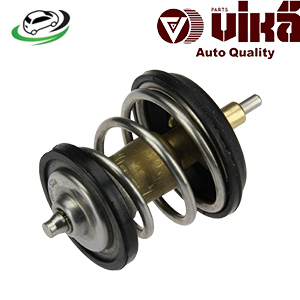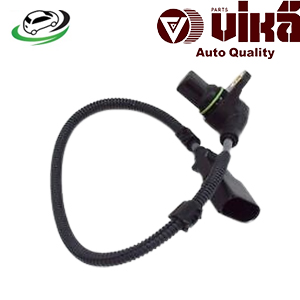-21%
Get VW Touareg V6 Executive/ Touareg VR6/ Touareg Base 3.6L/ Passat GT/ CC V6 Engine Crankshaft Position Sensor 03H906433
A crankshaft position sensor is an electronic device that monitors the position and speed of the engine’s crankshaft. It sends real-time data to the engine control unit (ECU), which uses this information to control various engine functions, including fuel injection, ignition timing, and engine idle speed.
The crankshaft is the part of the engine that translates the linear motion of the pistons into rotational motion, ultimately driving the wheels of the vehicle. To ensure smooth engine operation, the ECU must know the exact position of the crankshaft at all times.
Function of the CKP Sensor
- Ignition Timing Control: The CKP sensor provides data to the ECU to control ignition timing, ensuring that the spark plugs fire at the correct moment in the combustion cycle.
- Fuel Injection Timing: It helps in determining the precise moment to inject fuel into the combustion chamber for optimal power and fuel efficiency.
- Engine RPM Monitoring: By detecting the rotational speed of the crankshaft, the sensor helps the ECU regulate the engine’s RPM, ensuring smooth idling and acceleration.
- Synchronization with Camshaft: The crankshaft sensor works in conjunction with the camshaft position sensor to ensure that the intake and exhaust valves open and close at the right times.
2. Components of a Crankshaft Position Sensor
The crankshaft position sensor consists of the following key components:
1. Sensor Housing:
The housing of the sensor encases the internal components and protects them from external damage caused by heat, vibration, or debris. It is usually made of plastic or metal, depending on the design.
2. Magnetic Core:
Many CKP sensors are magnetic sensors, meaning they use a magnet to generate a magnetic field that changes as the crankshaft rotates. This change is detected by the sensor to determine the position of the crankshaft.
3. Sensor Element:
The sensor element inside the housing detects changes in the magnetic field or picks up signals from the reluctor wheel (a toothed metal wheel attached to the crankshaft) as it rotates.
4. Connector:
The sensor is connected to the ECU via an electrical connector, which allows the sensor to transmit signals to the ECU for engine management.
5. Wiring:
The sensor’s wiring connects it to the vehicle’s electrical system, allowing for the transmission of data to the ECU.
3. How the Crankshaft Position Sensor Works
The operation of a crankshaft position sensor is relatively simple in principle but highly sophisticated in execution. Here’s how it works:
- Signal Generation: As the crankshaft rotates, it turns a reluctor wheel or trigger wheel with teeth or notches. The CKP sensor monitors the rotation of this wheel and generates an electrical signal that corresponds to the wheel’s position and speed.
- Signal Transmission: The sensor continuously sends this signal to the ECU, which interprets the data to determine the exact position of the crankshaft in its rotation. This data is essential for controlling the timing of the engine’s functions.
- Synchronization with Camshaft Sensor: In engines that have both crankshaft and camshaft position sensors, the CKP sensor works in tandem with the camshaft sensor to synchronize valve timing with the crankshaft’s rotation.
- Pulse Signal: The CKP sensor typically generates a pulsed signal that corresponds to the position of each tooth on the reluctor wheel. These pulses are sent to the ECU, which calculates the crankshaft’s position and speed.
4. Types of Crankshaft Position Sensors
There are several different types of crankshaft position sensors, each with its own specific design and method of operation:
1. Magnetic Inductive Sensor (Variable Reluctance):
This type of sensor uses a magnet to generate a magnetic field around the reluctor wheel. As the teeth of the reluctor wheel pass by the sensor, they cause fluctuations in the magnetic field, which generates an electrical signal. Magnetic inductive sensors are commonly used in older vehicles.
2. Hall Effect Sensor:
A Hall effect sensor uses a magnetic field and a semiconductor to detect changes in the magnetic field caused by the rotating reluctor wheel. Unlike inductive sensors, Hall effect sensors generate a digital signal (on/off), making them ideal for modern vehicle systems.
3. Optical Sensor:
Optical crankshaft position sensors use a light source and a photoelectric sensor to detect the rotation of the crankshaft. These sensors are less common than magnetic or Hall effect sensors but provide high precision in measuring crankshaft position.
5. Benefits of the Crankshaft Position Sensor
The crankshaft position sensor is a crucial part of the engine management system, providing several important benefits:
1. Precise Engine Control:
The CKP sensor allows the ECU to precisely control ignition timing and fuel injection, optimizing engine performance and fuel efficiency.
2. Improved Fuel Economy:
With accurate timing control, the engine can operate more efficiently, leading to improved fuel economy.
3. Reduced Emissions:
Proper engine timing helps reduce harmful emissions by ensuring that fuel is burned more efficiently during the combustion process.
4. Smooth Engine Operation:
By constantly monitoring the crankshaft’s position, the sensor ensures smooth engine operation, reducing vibrations and engine misfires.
5. Safety and Reliability:
The crankshaft position sensor plays a key role in engine reliability. If the sensor detects any issues with the crankshaft’s position, it can send error codes to the ECU, allowing for prompt diagnosis and repair.
6. Common Issues with Crankshaft Position Sensors
While crankshaft position sensors are generally reliable, they can develop issues over time. Some common problems include:
1. Sensor Failure:
Over time, the sensor can wear out or become damaged due to heat, vibration, or exposure to contaminants. A failing CKP sensor can cause the engine to stall, misfire, or fail to start.
2. Signal Interruption:
If the sensor’s wiring becomes damaged or corroded, it can cause intermittent signals or a complete loss of signal to the ECU. This can lead to engine performance issues.
3. Magnetic Field Disruption:
In magnetic inductive sensors, metal debris can accumulate on the sensor, interfering with its ability to detect changes in the magnetic field. This can cause inaccurate readings and engine performance issues.
4. ECU-Related Issues:
Sometimes the problem lies not with the sensor itself but with the ECU’s ability to process the signal. Faulty software or a damaged ECU can result in improper sensor readings.
7. Diagnosing and Replacing a Faulty Crankshaft Position Sensor
When a CKP sensor starts to fail, it can trigger several warning signs, including:
- Check Engine Light: A faulty sensor often triggers the Check Engine light, alerting the driver to an issue with the engine’s timing.
- Engine Misfires or Stalling: The engine may misfire or stall due to incorrect timing information being sent to the ECU.
- Difficulty Starting the Engine: If the sensor fails completely, the ECU may not be able to detect the crankshaft’s position, causing the engine to fail to start.
Diagnosis:
To diagnose a faulty crankshaft position sensor, a mechanic will typically use a diagnostic scanner to read any error codes from the ECU. Common error codes related to the CKP sensor include P0335, P0336, and P0337.
Replacement:
Replacing a faulty crankshaft position sensor is relatively straightforward and can be done by most professional mechanics. The location of the sensor varies depending on the vehicle’s make and model, but it is typically found near the engine block or crankshaft pulley. The cost of replacement varies depending on the vehicle, but it’s generally an affordable repair.
8. Conclusion
The engine crankshaft position sensor is an essential component in modern vehicles, providing the ECU with critical data for controlling ignition timing, fuel injection, and engine speed. With its ability to improve engine performance, fuel efficiency, and emissions, the CKP sensor plays a vital role in ensuring the smooth operation of an internal combustion engine. Regular maintenance and timely replacement of a failing sensor are essential for maintaining optimal vehicle performance and preventing engine issues.
Follow us on Facebook for more parts.




Reviews
Clear filtersThere are no reviews yet.